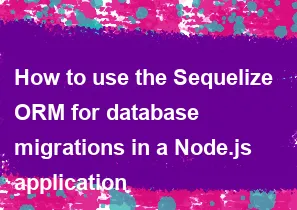How to use the Sequelize ORM for database migrations in a Node.js application

Sequelize is a popular Object-Relational Mapping (ORM) library for Node.js, and it provides a powerful set of features for working with databases. Migrations in Sequelize are a way to version-control your database schema and apply changes over time. Here's a step-by-step guide on how to use Sequelize for database migrations in a Node.js application:
Step 1: Install Sequelize and a Database Driver
Make sure you have Node.js installed on your machine. Create a new Node.js project if you haven't already, and then install Sequelize and a database driver of your choice (e.g., PostgreSQL, MySQL, SQLite).
bashnpm install sequelize sequelize-cli pg # for PostgreSQL
# or
npm install sequelize sequelize-cli mysql2 # for MySQL
# or
npm install sequelize sequelize-cli sqlite3 # for SQLite
Step 2: Initialize Sequelize
Run the following command to initialize Sequelize in your project:
bashnpx sequelize-cli init
This command will create a config, models, migrations, and seeders directory in your project.
Step 3: Configure Database Connection
Update the config/config.json file with your database connection details.
Step 4: Create a Model
Create a Sequelize model to represent your database table. For example, let's say you want to create a Users table:
bashnpx sequelize-cli model:generate --name User --attributes firstName:string,lastName:string,email:string
This command will generate a model file in the models directory.
Step 5: Run Migrations
Now, you can run the migration to create the Users table in your database:
bashnpx sequelize-cli db:migrate
Step 6: Modify the Model
If you need to make changes to your database schema, modify the generated model file in the models directory, and then create a new migration file using:
bashnpx sequelize-cli migration:generate --name modify-users
Edit the newly generated migration file in the migrations directory to define the changes you want to make.
Step 7: Apply the Changes
Run the migration again to apply the changes to your database:
bashnpx sequelize-cli db:migrate
Additional Tips:
To undo the last migration, you can use:
bashnpx sequelize-cli db:migrate:undoTo see the list of available commands, you can run:
bashnpx sequelize-cli --helpMake sure to check the Sequelize documentation for more advanced features and options: Sequelize Migrations.
That's it! You've successfully set up Sequelize for database migrations in your Node.js application.
-
Popular Post
- How to optimize for Google's About This Result feature for local businesses
- How to implement multi-language support in an Express.js application
- How to handle and optimize for changes in mobile search behavior
- How to handle CORS in a Node.js application
- How to use Vue.js with a UI framework (e.g., Vuetify, Element UI)
- How to configure Laravel Telescope for monitoring and profiling API requests
- How to create a command-line tool using the Commander.js library in Node.js
- How to implement code splitting in a React.js application
- How to use the AWS SDK for Node.js to interact with various AWS services
- How to use the Node.js Stream API for efficient data processing
- How to implement a cookie parser middleware in Node.js
- How to implement WebSockets for real-time communication in React
-
Latest Post
- How to implement a dynamic form with dynamic field styling based on user input in Next.js
- How to create a custom hook for handling user interactions with the browser's device motion in Next.js
- How to create a custom hook for handling user interactions with the browser's battery status in Next.js
- How to implement a dynamic form with dynamic field visibility based on user input in Next.js
- How to implement a dynamic form with real-time collaboration features in Next.js
- How to create a custom hook for handling user interactions with the browser's media devices in Next.js
- How to use the useSWRInfinite hook for paginating data with a custom loading indicator in Next.js
- How to create a custom hook for handling user interactions with the browser's network status in Next.js
- How to create a custom hook for handling user interactions with the browser's location in Next.js
- How to implement a dynamic form with multi-language support in Next.js
- How to create a custom hook for handling user interactions with the browser's ambient light sensor in Next.js
- How to use the useHover hook for creating interactive image zoom effects in Next.js